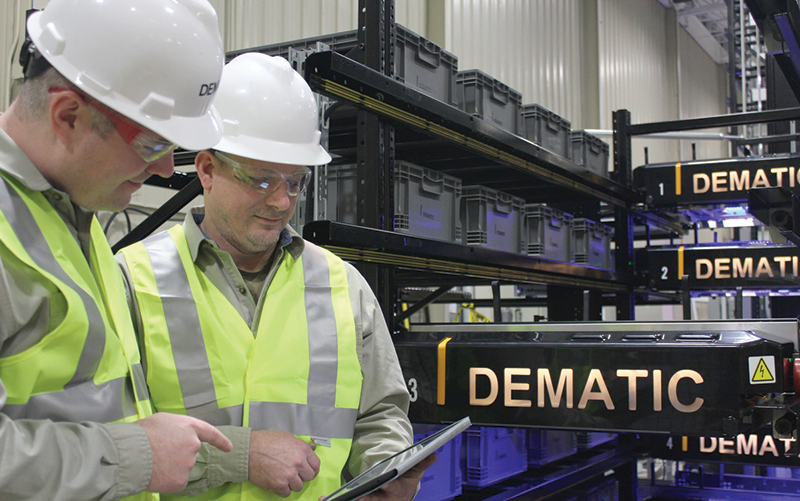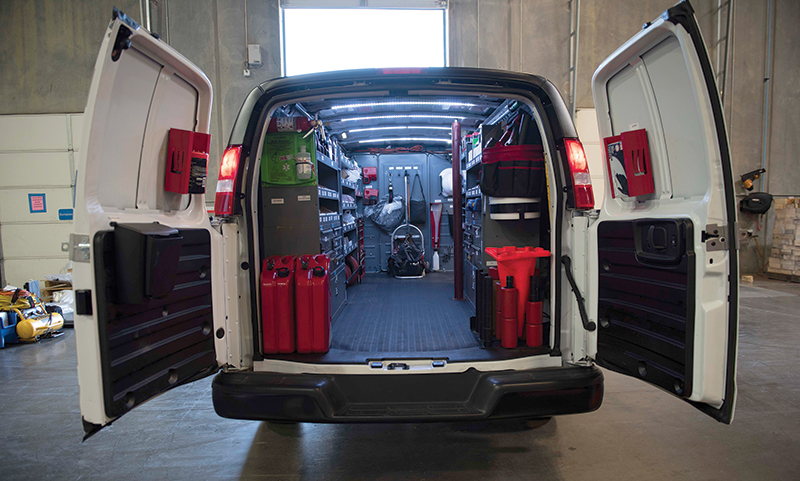Best Practices: The new look of MRO parts management
With supply chain pressures mounting, now is a good time to evaluate your MRO parts management operation and determine if it needs some new best practices.
“I’ve been at this for over 10 years, and I’ve never seen MRO parts activity like I’ve seen in the past year,” says Dave Trice. “Businesses are running equipment longer and harder and maintenance teams are leaner than ever. That’s leading to unique behavior in MRO parts management,” he adds.
Quite simply, companies are “experiencing a measured increase in parts procurement due to supply chain pressures,” says Trice, vice president of lifecycle performance services North America at MHS. He goes on to say this is not the same as consumer panic buying at the start of Covid. But it is notable with good reason.
“Companies can’t live with production or order fulfillment lines shut down for extended periods because they lack critical spares for materials handling equipment,” says Jim Owens, senior vice president of business development at SDI. “Companies are now looking at MRO parts management as a potential risk to not just their process efficiency and supply chain, but to their bottom line,” Owens continues.
All of that said, there’s a new look to best practices in MRO parts management. Here’s what several experts have to say about buying and having the right parts on hand before an incident.
Setting the stage
Let’s face it: MRO parts management historically has not exactly been a top priority at too many companies. Reasons range from not understanding the risk to operations to always being lucky enough to find, beg, borrow or steal (euphemistically, of course) parts when needed. Being able to muddle through has long been good enough. But, as Trice said, that is changing.
So: What are current practices and how are they affecting MRO parts management? Four organizations decided to take a look. The four include the Penn State Center for Supply Chain Research, Society for Maintenance & Reliability Professionals, Council of Supply Chain Management Professionals and SDI. Here’s what they found.

To begin, the average age of equipment assets is 24 years. More than 65% of MRO parts demand is reactive. In fact, 75% of the data that companies have about MRO parts inventory and purchasing is unactionable. Oh, yes, 97% of all parts lead times are inaccurate. That’s not a good start.
Moving on, 42% of all unplanned downtime can be attributed to poor internal supply chain practices with half of all work orders left hanging because techs are waiting for parts. Just as unfortunate, 30% of all in stock MRO parts are either excess or obsolete inventory.
Perhaps the best summary of those deficiencies is offered by Jamie Densmore, managing director EMEA at Synovos. “Too many people with responsibility for MRO parts management don’t know the scope of their program and what their deliverable should be.”
Some basics
Key words for best practices are strategy, culture, data, demand and fulfillment.
Perhaps the best starting point is with the strategy for MRO parts management, since that sets the tone for most everything else.
“The biggest challenge is if nobody owns MRO. Then parts management becomes a tangled mess of competing interests,” explains Owens. “The maintenance people want 10 of every part on hand. Procurement wants the lowest cost parts. Engineering wants the most reliable and durable. And finance wants to minimize total dollars invested in MRO parts,” he continues.
There is a flip side to all of this. Too often, MRO parts costs get lost in the shuffle of everyday activities. “Not only are parts not seen as a priority, but the costs here can be small enough in the bigger picture that they are completely overlooked,” says Brett Webster, director of digital software at Dematic.
The solution is for one person to have overall responsibility for the management of MRO parts from procurement to inventory levels to work order fulfillment. “That strategy also has to look at risk to company processes and the bottom line,” says Owens. “Somebody has to own the outcomes of MRO parts management and its impact on the bottom line.”
By now, culture enters the conversation.
“You need to have a culture of problem solvers,” says Chad Harrison, corporate service and parts manager at Malin, an authorized Raymond Solutions and Support Center. “Every tech and others involved with MRO parts has to understand that they directly influence success based on their personal behavior. They are stewards of the parts and know more about what is happening at the part level than anyone else. They know how to make the process better and need to be heard,” adds Harrison.
Communication is so important, says Webster. He says it’s not just what people communicate, but how they do it. Key examples he cites are: How does a work order proceed from start to finish? What are the communication gaps in the parts management process? How are warranty claims made?
The culture, Webster says, must be to document it all, and follow the process precisely.
It’s important to note here that not every company considers MRO parts management to be a core competency. Many rely on the expertise of a third party.
Densmore, Owens and Harrison all agree that communication is central to success here. It runs from service level agreements to on-site interactions between third-party program managers and the point person at the end user. “The end game,” says Densmore, “is to maintain the reliability of daily operations.”

The impact of data
That naturally leads to data—how it is collected and managed. And data is equally important to the purchasing people who buy them and the techs who need a part right now. Most unfortunately, data does not always get the respect it deserves.
The essentials here, says Webster, are identification of parts, quantities, location and accessibility. “It all has to be documented and well organized. You certainly don’t want purchasing to buy what isn’t needed,” he adds.
Densmore points out “you have to leverage data to get the best price on parts. And you have to standardize data before you can gain that leverage in the market.”
Unfortunately, it’s common for companies to do a poor job collecting and managing data. For instance, parts identifiers can be too imprecise and may not even include the name of the part supplier.
As a result, one part number may in reality apply to more than one part, masking the actual availability and precise location of the part in need. And if it is out of stock, a hunt is required to determine who supplied it in the first place.
The best practice, says Densmore, is to understand demand generation, spare parts availability and fulfillment steps. This includes lead times for critical parts. “Inventory management success rests on optimizing inventory levels based on criticality and demand,” he adds.

Harrison says it all comes down to inventory excellence.
While paper tracking is still widespread, software such as CMMS (computerized maintenance management system) software continues to make inroads. Webster estimates that 10 years ago, CMMS accounted for less than 5% of tracking systems and exceeds 50% today. In many cases, the CMMS is tied directly into the company’s enterprise resource planning (ERP) database and even its warehouse management system.
However, CMMS is not a slam dunk solution “because it’s rarely used properly,” says Owens of SDI.
Or as Trice of MHS says, “CMMS fails when a company buys it as software and not as a solution.” In other words, a successful CMMS program requires a disciplined, well documented and part specific approach to ensure the software precisely reflects the actual status of every part. “Typically, parts management is much cleaner with a successful CMMS,” adds Trice.
However, as Webster warns “as soon as people stop trusting what’s in the CMMS, it’s done. People will revert to paper tracking.”
Emerging practices
All this brings us to best practices for demand and fulfillment of MRO parts. Here are some emerging practices worth noting.
Spare parts demand fulfillment is always a challenge. The key question is: How do you get a part to its destination in the facility as quickly as possible?
The first new solution is actually borrowed from the automotive industry. Toyota Motor North America is installing an automated goods-to-person system to supply automotive spare parts to its distributors and keep up with demand in the automotive spare parts market, explains Robert Nilsson, vice president of sales and consulting at Swisslog. The system uses bots, mobile racks, pick stations and software that links to a CMMS.
Nilsson says there is no reason this strategy could not be applied to MRO parts fulfillment in larger facilities. “When you automate the parts fulfillment process, you bypass the stress of manual operations. Also, automation’s speed minimizes fulfillment times, which leads to keeping the equipment up and running in fast-moving, high-velocity environments,” he adds.
Getting parts closer to their point of use is central to a more distributed approach to parts storage, explains Trice. “Just putting more cabinets with critical parts in more locations on the floor gets the job done here,” he explains.
Trice also favors building kits of key, commonly used parts in storage areas. This way, he says, techs don’t have to wait to collect parts when a need arises. Instead, the kit is prebuilt and ready immediately.
Still another potentially emerging practice is 3D or additive manufacturing of parts on site, says Owens of SDI. While in the very early stages, this approach requires MRO parts to be scanned and digitally saved. As parts are needed, they’re printed on site using a 3D printer. The appeal of this approach is the elimination of standing inventory without sacrificing responsiveness of the tech team to a part failure.
That should be enough to get you going on building best practices in MRO parts management. Because, as Owens says, nobody wants to wait until after an MRO incident to get religion.

Article Topics
MRO News & Resources
Avidbots showcases autonomous cleaning robots Traka exhibits modular lockers MRO Survey: Finding and keeping the best technicians Maintenance, Repair and Operations: Understanding the true condition of the equipment Newly formed Bison combines AMETEK DFS and Bison Gear and Engineering Corp. Building (and maintaining) your maintenance, repair and operations (MRO) tech workforce The power side of lift truck battery and charger maintenance More MROLatest in Materials Handling
ASME Foundation wins grant for technical workforce development The (Not So) Secret Weapons: How Key Cabinets and Asset Management Lockers Are Changing Supply Chain Operations MODEX C-Suite Interview with Harold Vanasse: The perfect blend of automation and sustainability Consultant and industry leader John M. Hill passes on at age 86 Registration open for Pack Expo International 2024 Walmart chooses Swisslog AS/RS and software for third milk processing facility NetLogistik partners with Vuzix subsidiary Moviynt to offer mobility solutions for warehouses More Materials HandlingAbout the Author
Subscribe to Materials Handling Magazine

Find out what the world's most innovative companies are doing to improve productivity in their plants and distribution centers.
Start your FREE subscription today.
April 2024 Modern Materials Handling

Latest Resources












